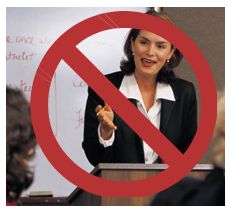As a keen watcher of lectures online, my initial reaction to this fierce assault on their value was hostile. But after watching this video again, I’ll admit that some valid points are being made.
No regular iij reader could have any doubt that the lecture format is alive and kicking in the online world. But for ‘leisurely historian’ Tad Suiter, they are outmoded and in need of replacement with more up to date online presentational approaches. He implies that they’re at least partially responsible for the high cost of college education, and have been superseded by multimedia tools. His arguments are well made, but his recommendations seem far too sweeping.
He concedes that lectures are still valid for communicating ‘basic’ information. His primary suggestions involve the substitution of a mixture of vlog-style ‘tutor’s face looking at you from a screen-mounted camera’ approach, with text and other visual materials interleaved into the teaching content.
Whilst nobody who has successfully used multimedia learning materials has any doubts that the approach that he’s recommending represents one aspect of the future of online educational resources, his dismissal of the lecture as a viable or commendable format (the book he cites in support of this position, Donald Bligh’s ‘What’s the Use of Lectures?’ points out that lectures are provably effective when supplemented by supporting material) seems akin to telling us that nobody will want go to the cinema to see movies any more, once they’ve seen TV.
He does introduce movies as a point of comparison, but only in the context of the visual experience. The point he’s missing here is that moviegoing is also an extremely popular social experience, which is why movie theaters haven’t become extinct.
Another point that escapes him, is that traditional lectures are not just ‘an acceptable format for basic factual information’ as he admits, but they are in fact the best format for certain types of content.
The TED talks format, where great care is taken to optimise the preparation and presentation of the talks for a live theater audience as well as for live broadcast, and also for online delivery, surely demonstrates, through its enormous and growing popularity, especially online, that the traditional lecture still retains a secure place in the future of educational and informative content. Interactive multimedia and non-interactive ‘storytelling’ presentations are not mutually exclusive and the content of the latter in fact provides ideal ‘construction material’ for the former.
The thought that cash-strapped universities could use his advice as a basis for cutting costs by eliminating live lectures just makes me shudder. Is the social experience of attending a live lecture audience really something we can afford to consign to oblivion in favour of having yet more talking heads in empty rooms ‘in our face’?
I certainly couldn’t articulate the value of the ‘conventional’ lecture in a 21st century university any more eloquently than June Cohen of TED. We’ve used this video in our own brief article on TED.


